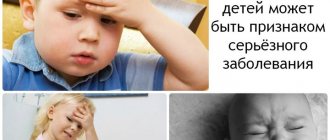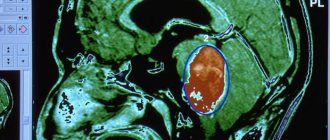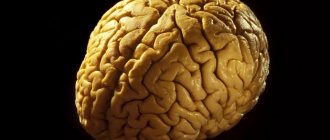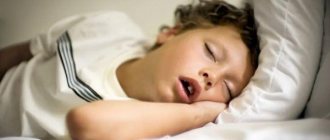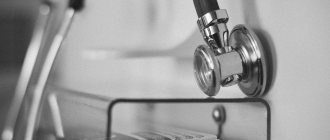MMD syndrome or, as it is also called in ICD-10, “hyperkinetic behavioral disorders” with code F-90, manifests itself already in early childhood. Minimal brain dysfunction suggests the presence of neurological disorders that are detected in the behavior and psychological reactions of the child. For example, these may be speech disorders, poor coordination of movements, hyperactivity, and learning difficulties.
Psychologically, disorders are expressed in emotional lability (instability), increased distractibility, and absent-mindedness. Parents need to take the manifestations of MMD very seriously, since according to the latest medical data, up to 25% of children have such a diagnosis.
Minimal cause brain dysfunction
Causes of minimal cerebral dysfunction MMD : severe pregnancy (especially the first half), toxicosis (gestosis), threat of miscarriage, harmful effects on the body of a pregnant woman of chemicals, radiation, vibration, infectious diseases, some microbes and viruses. These are premature and post-term births , weakness of labor and its prolonged course, lack of oxygen (hypoxia) due to compression of the umbilical cord, entanglement around the neck . After childbirth, poor nutrition, frequent or severe illnesses and infections accompanied by various kinds of complications, helminthic infestations and giardiasis, brain contusions, poisoning and unfavorable environmental conditions in the region have an adverse effect on the brain. A common cause of minimal cerebral dysfunction MMD is damage to the cervical spine during childbirth. Such damage can occur when the umbilical cord is entangled around the neck, forceps are applied, or incorrect obstetric manipulations.
Why does minimal brain dysfunction MMD occur?
Currently, minimal brain dysfunction MMD is considered as a consequence of early local brain damage, expressed in age-related immaturity of certain higher mental functions and their disharmonious development. With MMD, there is a delay in the rate of development of functional brain systems that provide such complex integrative functions as speech, attention, memory, perception and other forms of higher mental activity. In terms of general intellectual development, children with MMD are at the normal level, but at the same time they experience significant difficulties in school learning and social adaptation. Due to focal lesions, underdevelopment or dysfunction of certain parts of the cerebral cortex, MMD in children manifests itself in the form of disturbances in motor and speech development, development of writing skills (dysgraphia), reading (dyslexia), and counting (dyscalculia). A common variant of minimal brain dysfunction MMD is attention deficit hyperactivity disorder (ADHD).
Minimal brain dysfunction syndrome
The term “ minimal cerebral dysfunction ” became widespread in the late 1950s, when it began to be used in relation to a group of conditions of varying etiology and pathogenesis, accompanied by behavioral disorders and learning difficulties not associated with a general lag in intellectual development. The use of neuropsychological methods in the study of behavioral, cognitive and speech disorders observed in children with MMD allowed us to establish a certain relationship between the nature of the disorders and the localization of focal lesions of the central nervous system. The leading role in the occurrence of MMD belongs to brain hypoxia in the antenatal and intrapartum periods, especially in premature infants. Importance is attached to infectious, toxic and traumatic cerebral disorders, especially in early childhood. In children with minimal cerebral dysfunction MMD, in 25% of cases a complicated history of epilepsy, mental retardation, schizophrenia, migraine and other neuropsychiatric diseases is revealed, which indicates the role of a hereditary factor. In the mechanism of occurrence of MMD, hypofunction of the serotonin, dopamine and adrenergic systems is important.
With perinatal pathology, in 80% of children in the neonatal period, mild general cerebral and, less often, focal disorders are detected, usually diagnosed as perinatal encephalopathy, the manifestations of which are expressed by a delay in the rate of psychomotor development. In 20% of cases, in the presence of risk factors during pregnancy and childbirth, there are no neurological changes in the first months of life, and later they are characterized by various behavioral and autonomic disorders.
Which MMD clinic is in Russia? Minimal brain dysfunction MMD in preschool and early school age is characterized by a pronounced predominance of functional changes over organic ones. Children are hyperactive, cannot concentrate, cannot pay attention, are often distracted, and do not adapt well to unfamiliar surroundings. They have great difficulties while studying, they often show disturbances in perception, including their own body (they confuse the right and left sides, top and bottom), they are unable to distinguish parts from the whole, or distinguish a figure from the background; learning to write, count, and read is difficult . Sometimes there is a mirror spelling of numbers, a replacement of letters that are similar in spelling. Often, incorrect pronunciation of words is detected, auditory perception suffers, performance for abstract thinking and concept formation is reduced, and spatial representation is impaired. Increased impulsiveness and excitability, a low level of control are very characteristic, sometimes there is nail biting, finger sucking, head or body rocking, difficulties in contact with peers, and poor orientation in a team. During an external examination, children with MMD sometimes reveal a number of anomalies in the form of deformation of the skull, ears, abnormal growth of teeth, hypertelorism (an abnormality in the development of the skull bones, characterized by an increase in the distance between the eyeballs and the presence of a wide bridge of the nose), high palate, syndactyly (complete or partial fusion of adjacent fingers or toes). The neurological status can sometimes reveal a number of signs of mild organic brain damage: strabismus, asymmetry of nasolabial folds, muscle dystonia, impaired coordination of movements, asymmetry of tendon-periosteal reflexes, rarely pyramidal and extrapyramidal reflexes.
The children's movements are coordinated, in some cases there is digital apraxia (impaired purposeful action in the absence of muscle paralysis and the preservation of its constituent elementary movements). They have difficulty performing fine movements (fastening buttons, lacing shoes, sewing), draw poorly, and write in uneven and illegible handwriting. Autonomic disorders are also noted: increased sweating, lability of pulse and blood pressure, acrocyanosis (bluish coloration of the distal parts of the extremities), red persistent dermographism. Against this background, various neurosis-like disorders may occur: hyperactivity, tics, “nocturnal” enuresis, encopresis, stuttering. Clinical manifestations of minimal cerebral dysfunction MMD usually increase under the influence of infections, intoxications, stressful situations, allergization of the body, physical and/or mental stress.
A study of the anamnesis of Sarclinic patients shows that at an early age, many children with MMD exhibit hyperexcitability syndrome. Manifestations of hyperexcitability occur more often in the first months of life, in 20% of cases they occur after 8 months of life. Despite the correct regime and care, a sufficient amount of food, children are restless, they cry for no reason. It is accompanied by excessive motor activity, autonomic reactions in the form of redness or marbling of the skin, acrocyanosis, increased sweating, tachycardia, and increased breathing. During screaming, you can observe an increase in muscle tone, tremor of the chin, hands, clonus of the feet and legs, and spontaneous Moro reflex. Sleep disturbances (difficulty falling asleep for a long time, frequent spontaneous awakening, early awakening, startling), feeding difficulties and gastrointestinal disorders are also characteristic. Children have difficulty latching on the breast and are restless during feeding. Along with impaired sucking, there is a predisposition to regurgitation, and in the presence of functional neurogenic pyloric spasm, vomiting. The tendency to loose stools is associated with increased excitability of the intestinal wall, leading to increased intestinal motility under the influence of even minor irritants. Loose stools often alternate with constipation.
At the age of one to three years, children with MMD experience increased excitability, motor restlessness, sleep and appetite disturbances, poor weight gain, and some delay in psycho-speech and motor development. By the age of three, attention is drawn to such features as motor clumsiness, increased fatigue, distractibility, motor hyperactivity, impulsiveness, stubbornness and negativism. At a younger age, they often experience a delay in the formation of neatness skills (enuresis, encopresis).
As a rule, the increase in symptoms of minimal brain dysfunction MMD is timed to coincide with the start of kindergarten or school. This pattern is explained by the inability of the central nervous system to cope with the new demands placed on the child under conditions of increasing mental and physical stress. Increased stress on the central nervous system at this age often leads to behavioral disorders in the form of stubbornness, disobedience, negativism, as well as neurotic disorders and slower psycho-speech development. The maximum severity of MMD manifestations often coincides with critical periods of psychospeech development. The first period includes the age of 1–2 years, when intensive development of cortical speech zones and active formation of speech skills occur. The second period occurs at the age of 3 years. At this stage, the child’s stock of actively used words increases, phrasal speech improves, and attention and memory actively develop. At this time, many children with MMD exhibit delayed speech development and articulation disorders. The third critical period refers to the age of 6–7 years and coincides with the beginning of the development of written language skills (writing, reading). Children with MMD of this age are characterized by the development of school maladjustment and behavior problems. Significant psychological difficulties often cause various psychosomatic disorders and manifestations of vegetative-vascular dystonia.
How is the diagnosis carried out?
The course of diagnosis directly depends on the age of the child. If for toddlers 1–1.5 years old a regular test of reflexes may be informative, then after 5 years it does not give results and is replaced by psychodiagnostics.
The following tests and examinations help to definitively establish the diagnosis:
- electroencephalogram (EEG);
- neurosonography, which is performed before the age of 1 year through the infant fontanel;
- rheoencephalogram or “echo”. Ultrasound, passing through all parts of the brain, makes it possible to detect changes in its structure;
- computed tomogram or MRI, which determines the volume of the cortex and the integrity of the frontal parts of the brain;
- tests according to the Wechsler or Gordon system. These tasks provide a complete picture of the child’s psychosomatic state.
When going to the clinic, first visit your pediatrician, who will write a referral for examination or send you to a neurologist, neurologist or osteopath.
A visit to a massage therapist may also be required, who will “feel” the baby (problems with blood supply are often detected by such specialists). Important!
MRIs are prescribed only when necessary - the loud sounds produced by the equipment during the examination can frighten the child.
A mandatory attribute of any clinic - general blood and urine - in this case will not provide any tangible benefit. But an x-ray of the skull may be useful (if it has not been done at all up to this point).
If all these procedures indicate that the child has MMD, do not despair, because it is curable, and you can get rid of the diagnosis without resorting to complex manipulations.
How to treat minimal brain dysfunction, how to cure mmd in children in Saratov?
Thus, if in preschool age among children with minimal brain dysfunction MMD , hyperexcitability, motor disinhibition or, conversely, slowness, as well as motor clumsiness, absent-mindedness, distractibility, restlessness, increased fatigue, and behavioral characteristics (immaturity, infantilism, impulsiveness) predominate. Among schoolchildren, learning difficulties and behavioral disorders come to the fore. Children with MMD are characterized by weak psycho-emotional stability in the event of failures, self-doubt, and low self-esteem. They often also experience simple and social phobias, short temper, cockiness, oppositional and aggressive behavior. During adolescence, a number of children with MMD experience increased behavioral disturbances, aggressiveness, difficulties in relationships in the family and school, academic performance deteriorates, and a craving for alcohol and drug use appears. Therefore, parents’ efforts should be aimed at timely referral to specialists and comprehensive treatment of MMD. The Sarclinic doctor knows how to treat minimal brain dysfunction, how to cure mmd in children!
Possible complications
They are quite rare, but this does not mean that treatment can be overlooked. Neglect on the part of parents or medical “blunders” can result in serious consequences such as:
- vegetative-vascular dystonia or worsening problems with blood flow;
- complicated adaptation in society (the child becomes unsociable);
- for the same reason, self-doubt or persistently observed pessimism may appear;
- an overdose of stimulants can cause aggression;
- an incorrect balance of medications or excessive exercise only increases fatigue, thereby making it difficult to master the curriculum.
Did you know?
Karan Singh entered the Guinness Book of Records due to his height.
Already at 2 years old, this boy grew to 130 cm (with a weight of 42 kg). This is largely the “merit” of the mother - her figure is no less impressive 2.20 m. Fortunately, such consequences are very rare in practice, and children recover without complications.
Minimal brain dysfunction treatment, treatment of mmd in children
Sarklinik successfully applies complex reflexology methods for the treatment of minimal brain dysfunction in children . As a result of treatment of mmd in children , the activity of the serotonergic, dopaminergic and adrenergic systems, autonomic tone is normalized, attention, visual-spatial perception, spatial thinking, hand-eye coordination, auditory-verbal and visual memory are improved, cerebrasthenic symptoms, psychosomatic disorders, anxiety, various types of fears, obsession, motor disorders, oral speech disorders, emotional and volitional disorders, behavioral disorders, aggressiveness and oppositional reactions, school learning difficulties; reading and writing disorders, increased fatigue, moodiness, tearfulness, mood swings, poor appetite, headaches, sleep disturbances in the form of difficulty falling asleep, restless shallow sleep with disturbing dreams are eliminated. In most cases, regression of psychosomatic disorders is observed: causeless pain in the abdomen or in various parts of the body, enuresis, encopresis, parasomnias (night terrors, sleepwalking, sleep talking). Neurohumoral changes, pathological endocrine and neuroallergic reactions are normalized, and neurotic disorders that arise during the course of the disease are corrected.
Treatment of mmd in children in Russia
Treatment of minimal brain dysfunction in children (Russia, Saratov) leads to the following positive dynamics: there is a decrease in clumsiness, clumsiness, poor coordination of movements and difficulties in fine motor skills, improvement in attention characteristics, violations of which before treatment usually manifested themselves in the form of difficulties in concentrating when performing household and school assignments, during games, easy distractibility, inability to complete tasks independently, to complete a task, as well as the fact that children answered questions without thinking, without listening to them to the end, often lost their things in kindergarten, school or at home . At the same time, many children with MMD experience regression of emotional and volitional disorders (the child behaves inappropriately for his age, is small, shy, is afraid of not being liked by others, is overly touchy, cannot stand up for himself, considers himself unhappy), the severity of behavioral disorders decreases ( teases, explains, is sloppy, unkempt, noisy, disobedient at home, does not listen to the teacher or teacher, acts up in kindergarten or at school, deceives adults) and manifestations of aggressiveness and oppositional reactions (hot-tempered, unpredictable behavior, quarrels with children, threatens them, fights with children, is insolent and openly disobeys adults, refuses to fulfill their requests, deliberately commits acts that irritate other people, deliberately breaks and spoils things, treats pets cruelly). In the majority of children undergoing treatment in our clinic, the elimination of oral speech disorders, school learning difficulties, reading and writing disorders is reliably noted; in the majority of patients, by the end of the course of treatment, speech and school performance improve, reading, writing and arithmetic indicators in children with such problems are normalized pathologies such as dyslexia, dysgraphia and dyscalculia.
Stem structures and cerebral cortex are targets for MMD
Immaturity of the cerebral cortex often leads to the child becoming lethargic and lethargic. In addition to physical inactivity, emotional poverty, muscle weakness, impaired memory and attention will be observed. This is due to dysfunction of the brain stem structures, which do not properly influence the cerebral cortex, causing hypodynamic syndrome in the child.
The main thing when teaching such a child is patience and breaking the topic into logical parts, between which you can take a break for rest.
Effective treatment of minimal brain dysfunction in Saratov
The effectiveness of complex treatment of minimal cerebral dysfunction (MCD) , which may include reflexology, acupuncture, microacupuncture, laser reflexology, moxibustion, non-traditional and other techniques, reaches 95%. Treatment at Sarklinik is carried out on an outpatient basis and individually. All methods are safe.
Come and Sarklinik will help you! The Sarclinic doctor treats MMD in children. Treatment of minimal brain dysfunction in children in Saratov can improve the child’s memory, logic, speech, writing, and intelligence. MMD needs to be treated.
Sarklinik knows how to treat minimal brain dysfunction !
Sign up for a consultation. There are contraindications. Specialist consultation is required.
Photo: Legaa | Dreamstime.com\Dreamstock.ru. The people depicted in the photo are models, do not suffer from the diseases described and/or all similarities are excluded.
Related posts:
Encopresis in children, neurotic encopresis, treatment of encopresis
Enuresis, treatment of enuresis, how to treat nocturnal enuresis in Saratov, Russia
Sleepwalking in children, adults, treatment, somnambulism, sleepwalking
Paresis of the facial nerve in newborns, neuritis of the facial nerve in children, damage during childbirth
Cerebrasthenic syndrome: treatment, symptoms in children, adults

